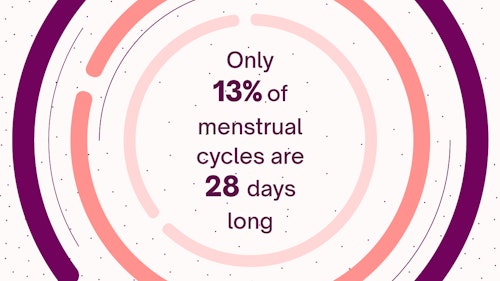Key takeaways
- In order to identify the fertile window, it is important to track biological parameters such as basal body temperature and not just cycle dates.
- The average menstrual cycle was 29 days long. Many believe that menstrual cycles are 28 days long however, this was the case for only 13% of cycles.
- Cycle characteristics are affected by factors such as cycle length, age, and BMI.
There are many assumptions about the menstrual cycle, and some of the most common ones are that a regular menstrual cycle is 28 days long, with ovulation happening on day 14 and a 14-day luteal phase. These assumptions have been widely accepted by both the general public and healthcare professionals, and there are many calendar-based fertility tracking apps that rely on this information.
In this study, (one of the largest of its kind), the aim was to use the large amount of real menstrual cycle data that we have at Natural Cycles to give a more accurate description of what menstrual cycles actually look like.
We set out to analyze 612,613 cycles, and specifically looked at cycle length, length of period bleeding, and length of the cycle phases (the follicular and luteal phase). We also wanted to see how these characteristics were affected by things such as age and BMI, as well as if cycle length impacted the other characteristics.
The results showed that most cycles (about 91%) were between 21 and 35 days long, and the average cycle length was 29.3 days. The average follicular phase was 16.9 days long and the average luteal phase was 12.4 days long. Interestingly, only 13% of cycles were 28 days long, and in these cycles, the average follicular phase was 15.4 days and the average luteal phase was 12.6 days.
When looking at the cycles that were shorter than 21 days and longer than 35 days in a bit more detail, we found that shorter cycles had slightly shorter periods, as well as shorter follicular and luteal phases compared to the cycles in the 21-35 day range. Longer cycles on the other hand had slightly longer bleeds and a much longer follicular phase, but the luteal phase did not change a lot.
In addition, we found that between the age of 25 and 45, cycles became shorter with increasing age — on average 0.18 days shorter per year. The average follicular phase length also decreased with age, while the luteal phase was not affected. This means that the shortening cycles were due to ovulation happening earlier.
When it comes to BMI, we found that users with a BMI below 18.5 had longer periods on average, while users with a BMI above 35 had more variation in their cycle length.
This study was able to show that there is a lot more variation in cycle characteristics than is generally recognized, and the assumed length of the 28-day cycle does not apply for most women. This information is valuable both for those looking to prevent pregnancy and conceive, as well as for healthcare professionals and educators in women’s health. It also highlights the potential of individualized cycle tracking using basal body temperature, since this is more accurate at finding the fertile window than those methods relying on outdated information about the menstrual cycle.
Lastly, we would like to thank our Cyclers who have agreed to share their data with us for research — this study would not be possible without them.
Original Paper
Summarised by
Freya Eriksson, Customer Support
Paper publication date
August, 2019
Paper authors
Jonathan R. Bull, Simon P. Rowland, Elina Berglund Scherwitzl, Raoul Scherwitzl, Kristina Gemzell Danielsson & Joyce Harper
